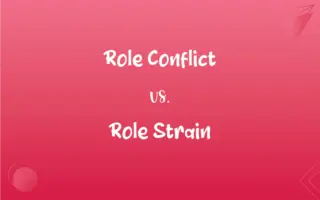.40 S&W vs. .45 ACP: What's the Difference?
Edited by Aimie Carlson || By Harlon Moss || Updated on October 3, 2023
The .40 S&W is a rimless pistol cartridge developed for law enforcement, while the .45 ACP is a larger caliber cartridge favored for its stopping power.

Key Differences
The .40 S&W and .45 ACP are both centerfire pistol cartridges, utilized extensively across various firearm platforms. The .40 S&W, developed jointly by Smith & Wesson and Winchester, aimed to offer an optimal balance between power and capacity. Meanwhile, the .45 ACP, also known as .45 Auto, was developed by John M. Browning in 1905 and has been widely used by the U.S. Military.
The .40 S&W typically offers a higher magazine capacity compared to the .45 ACP, owing to its smaller diameter. The .45 ACP, while possessing a larger diameter and generally delivering more stopping power, tends to offer fewer rounds per magazine due to its size.
Ballistically speaking, the .40 S&W offers a higher velocity, often translating to a flatter trajectory over close distances. In contrast, the .45 ACP is generally subsonic, and while it might offer more mass, it often travels at a slower velocity.
Recoil management varies between the .40 S&W and the .45 ACP. Some shooters find the snap of the .40 S&W to be sharper and potentially harder to manage in rapid succession. Conversely, while the .45 ACP does produce significant recoil, it is often described as more of a push than a snap, which some find easier to control.
When considering common usage, the .40 S&W is prevalent among law enforcement agencies, given its balance of capacity and power. The .45 ACP has a storied history with the U.S. military and enjoys a robust following among civilian shooters, particularly those who prioritize stopping power.
ADVERTISEMENT
Comparison Chart
Developed By
Smith & Wesson and Winchester
John M. Browning
Typical Magazine Capacity
Higher
Lower
Velocity
Generally higher
Generally lower (subsonic)
Recoil Character
Snappy
Push-like
Usage
Popular in law enforcement
Historically military, popular for stopping power
ADVERTISEMENT
.40 S&W and .45 ACP Definitions
.40 S&W
A centerfire pistol cartridge developed jointly by Smith & Wesson and Winchester.
The .40 S&W is recognized for its balanced performance.
.45 ACP
A large caliber pistol cartridge developed by John M. Browning.
The .45 ACP is historically associated with U.S. military use.
.40 S&W
Noted for its relatively high-velocity compared to larger calibers.
Due to its velocity, the .40 S&W exhibits a flatter trajectory over short distances.
.45 ACP
Recognized for a push-like recoil, distinguishing it from snappier calibers.
The .45 ACP’s recoil is substantial but is often described as manageable due to its pushing nature.
.40 S&W
Often favored in law enforcement due to its balance of capacity and power.
Many police departments issue sidearms chambered in .40 S&W.
.45 ACP
Generally exhibits a subsonic velocity, often making it quieter with suppressors.
The .45 ACP's often subsonic nature lends well to suppressed firing.
.40 S&W
Generally offers a higher magazine capacity than larger calibers.
The .40 S&W provides a pragmatic balance between magazine capacity and stopping power.
.45 ACP
Frequently noted for its historical significance and use in classic firearms.
Iconic firearms, such as the M1911, are chambered in .45 ACP.
.40 S&W
Typically described as having a sharp, snappy recoil.
Some shooters practice extensively to manage the .40 S&W's characteristic recoil.
.45 ACP
Renowned for its stopping power, typically using larger projectiles.
Many enthusiasts choose .45 ACP for its notable stopping power.
FAQs
Who developed the .45 ACP?
John M. Browning.
Who developed the .40 S&W?
Smith & Wesson and Winchester.
Which cartridge usually allows for a higher magazine capacity?
The .40 S&W.
Does the .45 ACP have a rich history in firearms design and use?
Yes, it has been used in numerous iconic firearms throughout history.
Is the .40 S&W typically higher in velocity than the .45 ACP?
Yes, generally it has higher velocity.
What is a notable firearm chambered in .45 ACP?
The M1911.
Is the .45 ACP typically subsonic?
Yes, it generally is.
Is the .45 ACP known for its role in U.S. military history?
Yes, it has a significant historical role.
Which cartridge is older in terms of development?
The .45 ACP.
Which cartridge is commonly found in law enforcement use?
The .40 S&W.
Which is often preferred for suppressed shooting?
The .45 ACP due to its often subsonic nature.
Which cartridge tends to offer a flatter trajectory over close distances?
The .40 S&W.
Which cartridge is newer in development?
The .40 S&W.
Is the .40 S&W known for balancing capacity and power?
Yes, it's recognized for that balance.
Which caliber typically has larger bullet diameters?
The .45 ACP.
Do both the .40 S&W and .45 ACP have military and law enforcement use?
Yes, both have been utilized in various capacities.
Which cartridge is typically associated with greater stopping power?
The .45 ACP.
Which cartridge is known for a snappy recoil?
The .40 S&W.
Which tends to have more rounds in a magazine, .40 S&W, or .45 ACP?
Generally, the .40 S&W.
Is the recoil of the .45 ACP often considered a "push"?
Yes, it's frequently described as such.
About Author
Written by
Harlon MossHarlon is a seasoned quality moderator and accomplished content writer for Difference Wiki. An alumnus of the prestigious University of California, he earned his degree in Computer Science. Leveraging his academic background, Harlon brings a meticulous and informed perspective to his work, ensuring content accuracy and excellence.
Edited by
Aimie CarlsonAimie Carlson, holding a master's degree in English literature, is a fervent English language enthusiast. She lends her writing talents to Difference Wiki, a prominent website that specializes in comparisons, offering readers insightful analyses that both captivate and inform.








































































